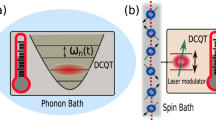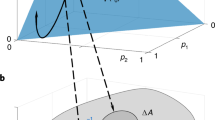Abstract
Heat flow between a large thermal ‘bath’ and a smaller system brings them progressively closer to thermal equilibrium while increasing their entropy1. Fluctuations involving a small fraction of a statistical ensemble of systems interacting with the bath result in deviations from this trend. In this respect, quantum and classical thermodynamics are in agreement1,2,3,4,5. Here we predict a different trend in a purely quantum mechanical setting: disturbances of thermal equilibrium between two-level systems (TLSs) and a bath6, caused by frequent, brief quantum non-demolition7,8,9,10 measurements of the TLS energy states. By making the measurements increasingly frequent, we encounter first the anti-Zeno regime and then the Zeno regime (namely where the TLSs’ relaxation respectively speeds up and slows down11,12,13,14,15). The corresponding entropy and temperature of both the system and the bath are then found to either decrease or increase depending only on the rate of observation, contrary to the standard thermodynamical rules that hold for memory-less (Markov) baths2,5. From a practical viewpoint, these anomalies may offer the possibility of very fast control of heat and entropy in quantum systems, allowing cooling and state purification over an interval much shorter than the time needed for thermal equilibration or for a feedback control loop.
This is a preview of subscription content, access via your institution
Access options
Subscribe to this journal
Receive 51 print issues and online access
$199.00 per year
only $3.90 per issue
Buy this article
- Purchase on Springer Link
- Instant access to full article PDF
Prices may be subject to local taxes which are calculated during checkout


Similar content being viewed by others
References
Landau, L. & Lifshitz, E. Statistical Physics 3rd edn Part 1 (Pergamon, 1980)
Spohn, H. Entropy production for quantum dynamical semigroups. J. Math. Phys. 19, 1227–1230 (1978)
Alicki, R. The quantum open system as a model of the heat engine. J. Phys. A 12, L103–L107 (1979)
Jarzynski, C. Nonequilibrium equality for free energy differences. Phys. Rev. Lett. 78, 2690–2693 (1997)
Lindblad, G. Expectations and entropy inequalities for finite quantum systems. Commun. Math. Phys. 39, 111–119 (1974)
Gelman, D. & Kosloff, R. Simulating dissipative phenomena with a random phase thermal wavefunctions, high temperature application of the Surrogate Hamiltonian approach. Chem. Phys. Lett. 381, 129–138 (2003)
Zurek, W. H. Decoherence, einselection, and the quantum origins of the classical. Rev. Mod. Phys. 75, 715–775 (2003)
Braginsky, V. & Khalili, F. Quantum Measurement (Cambridge Univ. Press, Cambridge, 1995)
Barnett, S. Turning on quantum taps. Nature 362, 113 (1993)
Haroche, S. & Raimond, J. Exploring the Quantum: Atoms, Cavities, and Photons (Oxford Univ. Press, Oxford, 2006)
Misra, B. & Sudarshan, E. C. G. Zeno’s paradox in quantum theory. J. Math. Phys. 18, 756–763 (1977)
Lane, A. M. Decay at early times - larger or smaller than the golden rule. Phys. Lett. 99A, 359–360 (1983)
Kofman, A. G. & Kurizki, G. Acceleration of quantum decay processes by frequent observations. Nature 405, 546–550 (2000)
Facchi, P. & Pascazio, S. Quantum Zeno and inverse quantum Zeno effects. Prog. Opt. 42, 147–217 (2001)
Kofman, A. G. & Kurizki, G. Unified theory of dynamically suppressed qubit decoherence in thermal baths. Phys. Rev. Lett. 93, 130406 (2004)
Schulman, L. S. & Gaveau, B. Ratcheting up energy by means of measurement. Phys. Rev. Lett. 97, 240405 (2006)
Allahverdyan, A. E. & Nieuwenhuizen, T. M. Extraction of work from a single thermal bath in the quantum regime. Phys. Rev. Lett. 85, 1799–1802 (2000)
Allahverdyan, A. E., Gracià, R. S. & Nieuwenhuizen, T. M. Bath-assisted cooling of spins. Phys. Rev. Lett. 93, 260404 (2004)
Cohen-Tannoudji, C., Dupont-Roc, J. & Grynberg, G. Atom-Photon Interactions (Wiley, New York, 1992)
Scully, M. O. Extracting work from a single thermal bath via quantum negentropy. Phys. Rev. Lett. 87, 220601 (2001)
Beck, M., Jäckle, A., Worth, G. & Meyer, H.-D. The multiconfiguration time-dependent Hartree (MCTDH) method: a highly efficient algorithm for propagating wavepackets. Phys. Rep. 324, 1–105 (2000)
Nest, M. & Meyer, H. Dissipative quantum dynamics of anharmonic oscillators with the multiconfiguration time-dependent Hartree method. J. Chem. Phys. 119, 24–33 (2003)
Stelmachovic, P. & Buzek, V. Dynamics of open quantum systems initially entangled with environment: Beyond the Kraus representation. Phys. Rev. A 64, 062106 (2001)
Scully, M. O., Zubairy, M. S., Agarwal, G. S. & Walther, H. Extracting work from a single heat bath via vanishing quantum coherence. Science 299, 862–864 (2003)
Acknowledgements
We acknowledge the support of DIP, GIF and EC (SCALA IP and MIDAS STREP).
Author information
Authors and Affiliations
Corresponding author
Supplementary information
Supplementary information
The file contains Supplementary Notes. (PDF 252 kb)
Rights and permissions
About this article
Cite this article
Erez, N., Gordon, G., Nest, M. et al. Thermodynamic control by frequent quantum measurements. Nature 452, 724–727 (2008). https://doi.org/10.1038/nature06873
Received:
Accepted:
Issue Date:
DOI: https://doi.org/10.1038/nature06873
This article is cited by
-
Anti-Zeno purification of spin baths by quantum probe measurements
Nature Communications (2022)
-
Few-qubit quantum refrigerator for cooling a multi-qubit system
Scientific Reports (2021)
-
On the Possibility to Observe Relations Between Quantum Measurements and the Entropy of Phase Transitions in Zn2(BDC)2(DABCO)
Foundations of Physics (2021)
-
Anti-Zeno quantum advantage in fast-driven heat machines
Communications Physics (2020)
-
A new approach to study the Zeno effect for a macroscopic quantum system under frequent interactions with a harmonic environment
Scientific Reports (2019)
Comments
By submitting a comment you agree to abide by our Terms and Community Guidelines. If you find something abusive or that does not comply with our terms or guidelines please flag it as inappropriate.



